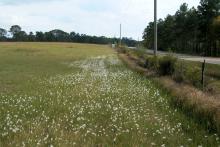Information Possibly Outdated
The information presented on this page was originally released on September 19, 2003. It may not be outdated, but please search our site for more current information. If you plan to quote or reference this information in a publication, please check with the Extension specialist or author before proceeding.
Invasive weed threatens state
MISSISSIPPI STATE -- A non-native weed is threatening state roadsides, pastures and forests, and while it may not spread as fast as kudzu, it is dangerously invasive.
Cogongrass is an aggressive warm-season, perennial grass that is difficult to control. It is native to southeast Asia and was accidentally introduced to the United States in 1911 at Grand Bay, Ala. It spread to other states in the 1920s as Experiment Stations evaluated it as a potential forage crop in Mississippi, Florida and Alabama.
Although it produces a tremendous plant mass, researchers can find no use for it. It looks like it would be a good forage, but it is unpalatable to livestock and low in nutritional value.
John Byrd, Extension weed scientist with Mississippi State University, said cogongrass infests forests, roadsides, unimproved pastures and wildlife areas.
"This is a very aggressive weed that can completely dominate sites," Byrd said.
The weed forms a dense, usually circular stand and grows from 1 to 4 feet high depending on the soil's productivity. It chokes everything else out of the area where it is growing, and it is easy to identify in the winter because it is a lighter brown than native warm-season grasses.
There are more than a billion acres of the weed worldwide, and several thousand acres of it in the southeast United States.
"In 1979, there were 19 counties with reported cogongrass infestations. Today, there are 47 counties with this invasive weed," Byrd said.
Most of the northern third of the state, the Delta and the western area down to Louisiana are clear of this weed, but scattered populations have been found north of Tupelo and in Yazoo, Franklin and Adams counties. Byrd said the weed is continuing its spread and should be capable of surviving in north-central Illinois, throughout the northeastern United States and as far northwest as parts of Oregon and Washington.
"Cogongrass invades low-maintenance areas or areas not in cultivation," Byrd said. "It appears that it can release chemicals into the soil that inhibit the growth of other plants. When you combine that with its dense populations, it basically out-competes anything else that has wildlife value or forage value that might grow at these sites."
In Mississippi, the weed comes out of winter dormancy and blooms from late March through mid-May, then grows all summer. Native warm-season grasses come out of winter dormancy, grow all summer and then bloom.
Cogongrass spreads through seeds or rhizomes. Seeds are attached to a plume of long hairs and are dispersed by the wind over long distances.
"A single plant can produce 700 to 3,000 seeds," Byrd said. "Previous research showed that 95 percent germinate within seven days of harvest, and seeds remain viable after one year."
Rhizomes are underground, horizontal stems capable of producing roots or shoots at each node. Byrd said cogongrass produces a very thick mat of rhizomes, and spreads most prolifically in this way. Equipment such as log trucks, farm machinery, bushhogs and road machinery can carry dirt contaminated with cogongrass rhizomes to new locations, spreading the weed further.
News Story Contact
Your Extension Experts
Related News
Pages
Related Publications
Pages
- « first
- ‹ previous
- 1
- 2
- 3





